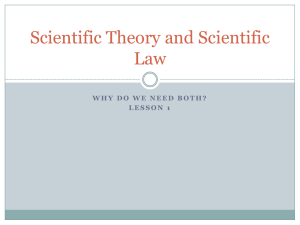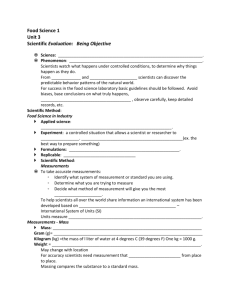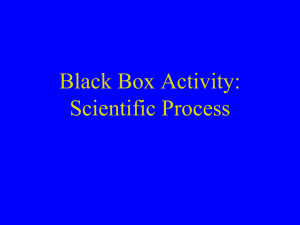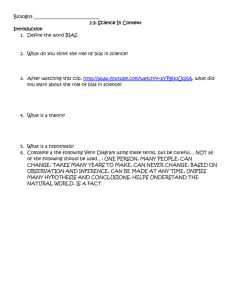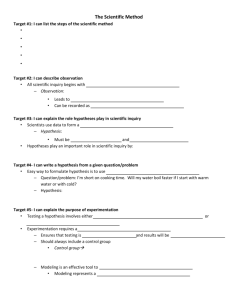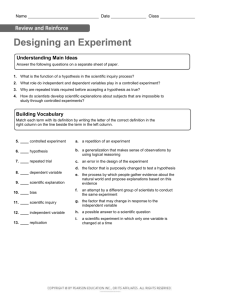printer-friendly version
advertisement
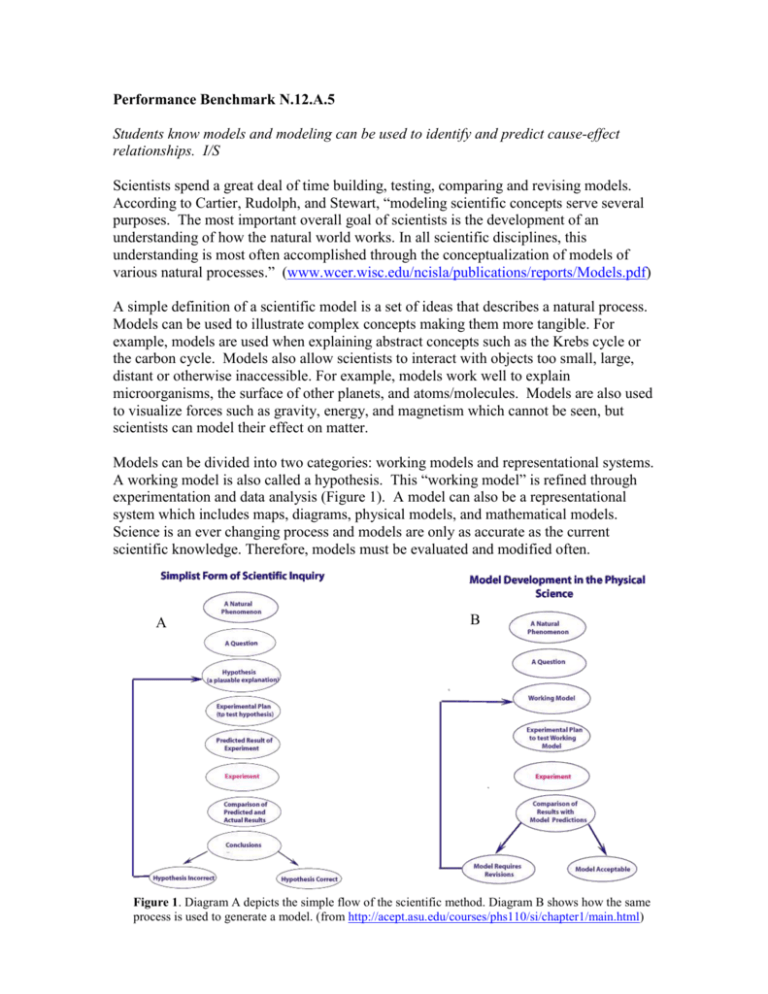
Performance Benchmark N.12.A.5 Students know models and modeling can be used to identify and predict cause-effect relationships. I/S Scientists spend a great deal of time building, testing, comparing and revising models. According to Cartier, Rudolph, and Stewart, “modeling scientific concepts serve several purposes. The most important overall goal of scientists is the development of an understanding of how the natural world works. In all scientific disciplines, this understanding is most often accomplished through the conceptualization of models of various natural processes.” (www.wcer.wisc.edu/ncisla/publications/reports/Models.pdf) A simple definition of a scientific model is a set of ideas that describes a natural process. Models can be used to illustrate complex concepts making them more tangible. For example, models are used when explaining abstract concepts such as the Krebs cycle or the carbon cycle. Models also allow scientists to interact with objects too small, large, distant or otherwise inaccessible. For example, models work well to explain microorganisms, the surface of other planets, and atoms/molecules. Models are also used to visualize forces such as gravity, energy, and magnetism which cannot be seen, but scientists can model their effect on matter. Models can be divided into two categories: working models and representational systems. A working model is also called a hypothesis. This “working model” is refined through experimentation and data analysis (Figure 1). A model can also be a representational system which includes maps, diagrams, physical models, and mathematical models. Science is an ever changing process and models are only as accurate as the current scientific knowledge. Therefore, models must be evaluated and modified often. A . B . Figure 1. Diagram A depicts the simple flow of the scientific method. Diagram B shows how the same process is used to generate a model. (from http://acept.asu.edu/courses/phs110/si/chapter1/main.html) Working Models (hypotheses) The definition of a hypothesis is difficult for students to understand. When asked, students often rotely respond that a hypothesis is an “educated guess”. This is an overly simplified definition that is often used by teachers. A better definition for students is to describe a hypothesis as a “working model” (Figure 1). Based on current data, scientists develop a working idea of how a system works. Scientists then use this working model to predict cause and effect relationships and design experimentation to test the working model. Finally, scientists revise or accept the working model based on their results. Students will recognize this process as the scientific method. The definition of a hypothesis as a working model rather than an “educated guess,” enables students to apply the term in more situations. Figure 2. The human circulatory system. (from http://instruct1.cit.cornell.edu/courses/biog105/pages/demos/105/unit7/circsystem.html) The simple definition of a scientific model is a set of ideas that describes a natural process. For example, the circulation model in human anatomy illustrates the cellular level to system level that covers the chemistry, physics, and biology of how and why blood moves around the body (Figure 2). Further detail about the circulatory system can be found in the TIPS L12B2 performance benchmark. Representational Systems Physical Models A majority of people are familiar with physical models because they have been using them their entire lives. For example, many individuals played with Legos, blocks, toy cars, and Barbies as children. Scientists often build physical representations to have a tangible, manipulatable example of what they are studying. These representations allow scientists to “see” things that are difficult to observe. For example, when constructing a model of a virus (Figure 3) and a cell (Figure 4), a scientist can investigate the relationship between the two components by manually manipulating the models. Physical models can be built to represent a variety of scientific ideas from planetary systems to atomic structure. As new information and evidence becomes available, models are modified to fit new parameters defined by experimentation. The model of the sun, Earth, and moon in Figure 5 was constructed in 1712 by John Rowley based on the information available at the time. Visit http://www.spaceplace.wisc.edu/scalemodel.shtml for instructions on how to construct a scale model of the sun, earth, and moon based on current data. Figure 3. A model of HIV enlarged 1,000,000 times. (from http://ewake.wfubmc.edu:88/library/ Models/Models/IMAGESMODEL/ QW_1685_H6A288_1996.jpg) Figure 4. A model of an animal cell magnified 12,000 times. (from http://learning.mgccc.cc.ms.us/scien ce/notes/material.html) Figure 5. A model of the sun, earth and moon constructed in 1712. (from http://www.sciencemuseum.org.uk/im ages/I002/10197368.aspx) Diagrams Physical models in two dimensions are called diagrams. Diagrams include labeled schematics of physical objects and flow charts to illustrate a complex process. A pictorial display is a tool that allows the reader to visualize cause and effect relationships between physical parts or a process. See Figure 6 for examples of diagrams. Figure 6. Several examples of diagrams. Phylogeny for Life (from http://biology.unm.edu/ccouncil/Biology_203/Summaries/Phylogeny.htm) Free Body Diagram (from http://panda.unm.edu/Courses/Price/Phys160/Ftest2.jpeg) Complex Electrical Circuit (from http://www.evl.uic.edu/EVL/VROOM/IMAGES/chua.circuit.diagram.gif) Mathematical A mathematical model is a model that uses mathematical language as an abstract representation of a scientific concept. The model predicts the behavior of a system within a given set of assumptions. Therefore, you must know the parameters of the mathematical model before applying it to a new situation. Figure 7: The Hardy-Weinberg Equations. p + q = 1 p2 + 2pq + q2 = 1 p = frequency of one of two alleles q = frequency of the other allele There are many mathematical models in science. One example is the Hardy-Weinberg equilibrium model which consists of two equations that work in tandem to predict genotypic and allelic frequencies in a population (Figure 7). Knowing the frequency of one of the two alleles in a population, you can predict the frequency of the other. You can also predict what would happen to the system when one frequency is changed. This equation was formulated in the early 1900s. This model was developed over time through careful experimentation and modified as needed. A set of assumptions and exclusions were also developed to refine the situations where the model was applicable. Performance Benchmark N.12.A.5 Students know models and modeling can be used to identify and predict cause-effect relationships. I/S Common misconceptions associated with this benchmark: 1. Students incorrectly believe that a model is static. Any designed model must be flexible to allow the addition of newly discovered items or relationships. For example, the reclassification of Pluto has changed the model of our solar system. Models change as more information is discovered. 2. Students incorrectly believe that there is only one accepted model per concept. Many models may be designed to explain a phenomenon using the same data set to meet the needs of the user. One scientist may be interested in macro level relationships while another may design a model that shows micro level relationships. Therefore, a model may be extremely simple or very complicated when more specificity is needed. 3. Students inaccurately believe models always make accurate predictions. “We can make predictions for simple systems more easily than for complex systems. It is very difficult to predict the evolution of a complex system far into the future. An example of this is the accurate prediction of weather. In order to update their models, meteorologists must constantly monitor and update parameters such as temperature, pressure, humidity, wind, solar radiation, etc.” For additional common misconceptions about science visit http://www.digital-recordings.com/publ/pubscie.html#science Performance Benchmark N.12.A.5 Students know models and modeling can be used to identify and predict cause-effect relationships. I/S Sample Test Questions 1. The model below is set up to show how a lunar eclipse occurs. What is the greatest limitation of this model? (Figure reference: http://www.tea.state.tx.us/student.assessment/resources/online/2006/grade8/science/8science.htm) a. b. c. d. The light bulb is standing straight up instead of tilted on an axis. Comparative sizes and distances are inaccurate The shadow is being cast in the wrong direction The heat released is much less than that released by the sun. 2. If the Corn and Oats were removed from the food web above, which of the following will be most affected? a. mice and rats b. hawks and owls c. snakes and raccoons d. grasshoppers and crickets 3. Which of the following is not a reason for using models in science? a. Visualize objects too small, large, or distant to see b. Predict cause and effect relationships c. Provide a working hypothesis d. To construct a final representation of object studied 4. Which of the following statements is false? All models must a. be accepted by all scientists working in field b. be supported by experimental data c. evolve as new data is analyzed d. show relationships between components Performance Benchmark N.12.A.5 Students know models and modeling can be used to identify and predict cause-effect relationships. I/S Answers to Sample Test Questions 1. 2. 3. 4. (b) (a) (d) (a) Performance Benchmark N.12.A.5 Students know models and modeling can be used to identify and predict cause-effect relationships. I/S Intervention Strategies and Resources The following list of intervention strategies and resources will facilitate student understanding of this benchmark. 1. Science NetLinks: Evaluating Mathematical Models This website “uses the Internet to evaluate a variety of mathematical models. Because mathematics plays such a central role in modern culture, scientifically literate students must develop a basic understanding of the nature of mathematics. It is important for students to realize that mathematics, like science and technology, incorporates both finding answers to fundamental questions and solving practical problems.” To access these activities, go to http://www.sciencenetlinks.com/lessons_printable.cfm?DocID=132 2. FORSEA: If I Can’t See It, How Do I Know It’s There? This lesson has students constructing a model of the ocean floor using a closed shoe box with a lid with holes spaced in a 1cm grid. Students use bamboo skewers to assess the shapes in the box and transfer their data into a topographic model. This activity can be found at http://forsea.org/CD9PH.html 3. My NASA Data Lesson: Interpreting CERES Cloud Data and Weather Maps This lesson asks students to correlate a satellite image with satellite data collected over the United States during a winter storm. This activity is appropriate for students who are capable of cross referencing several sources of data. Students also need to be proficient in working with latitude and longitude coordinates. This activity can be modified to meet the needs of your students. To link to this activity, go to http://mynasadata.larc.nasa.gov/Storm_Clouds.html
